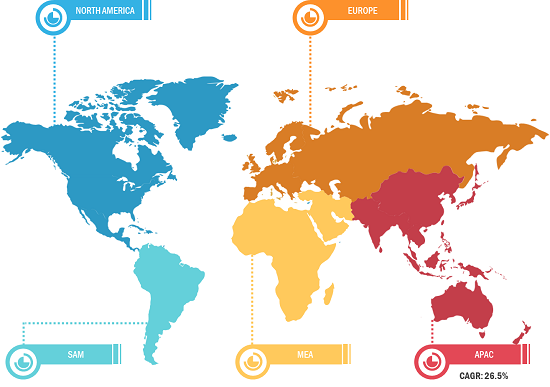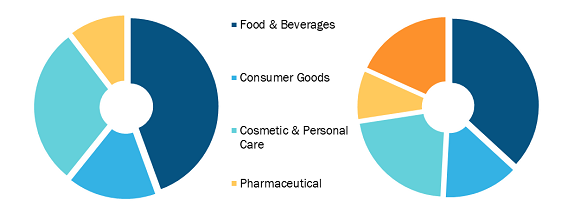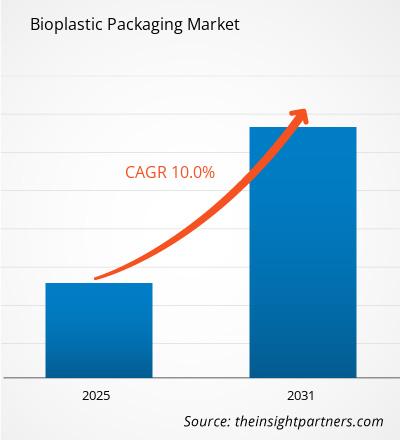Le marché des emballages bioplastiques devrait atteindre 47 991,9 millions de dollars américains d'ici 2031, contre 47 991,9 millions de dollars américains d'ici 2031. 13 273,9 millions en 2022. Il devrait croître à un TCAC de 23,9 % entre 2022 et 2031.
Alimentation et amp; boissons, biens de consommation, cosmétiques et amp; Les secteurs des soins personnels et des produits pharmaceutiques comptent parmi les principaux utilisateurs finaux d'emballages bioplastiques. Les emballages en plastique sont largement utilisés dans diverses applications telles que les produits de grande consommation, les produits alimentaires et autres. boissons, produits pharmaceutiques et biens de consommation. Cette utilisation accrue du plastique dans plusieurs applications est responsable de l’augmentation de la pollution plastique. Ainsi, le recyclage et la réutilisation du plastique deviennent importants pour l’innovation et la durabilité. De plus, le plastique conventionnel devrait devenir plus cher à l’avenir en raison de la diminution des sources de matières premières. Au cours des dernières années, le bioplastique a influencé l’industrie du plastique grâce à l’innovation visant à accroître l’efficacité des ressources, la fonctionnalité et la durabilité. Le bioplastique joue un rôle important dans l'augmentation des objectifs de recyclage et l'amélioration de la gestion des déchets en remplaçant les ressources pétrolières par des ressources renouvelables. Les bioplastiques sont fabriqués à partir de ressources végétales renouvelables, qui offrent une faible toxicité, une meilleure recyclabilité et une biodégradabilité élevée.
En 2021, l'Europe détenait une part importante du marché des emballages bioplastiques. De nombreuses petites et grandes entreprises manufacturières sont présentes dans la région. La préférence croissante des consommateurs pour les polymères biologiques et naturels dans les emballages alimentaires influence positivement le taux d'adoption de ces solutions d'emballage durables dans le secteur alimentaire et industriel. secteur des boissons dans la région. Outre la sensibilisation des consommateurs, la multiplication des initiatives gouvernementales encourageant l'utilisation de produits d'emballage respectueux de l'environnement dans différents pays renforce la croissance du marché.
Aperçus stratégiques
Impact de la pandémie de COVID-19 sur le marché des emballages bioplastiques
Alimentation et amp; boissons, biens de consommation, cosmétiques et amp; Les industries des soins personnels et pharmaceutiques figuraient parmi les principaux générateurs de demande sur le marché des emballages bioplastiques avant le début de la pandémie de COVID-19. Cependant, le marché a été confronté à des obstacles au premier trimestre 2021 en raison de fermetures d’entreprises, de pénuries de matières premières et d’indisponibilité de main-d’œuvre. La pandémie de COVID-19 a entraîné une récession économique au cours des premiers mois de 2021, ce qui a créé un fardeau financier pour les fabricants et les consommateurs. Cependant, l'assouplissement des restrictions sociales et la multiplication des initiatives gouvernementales visant à stimuler l'économie ont encouragé les industries à commencer à fonctionner à pleine capacité. Cela a finalement contribué à la relance du marché des emballages bioplastiques fin 2021.
Répartition du marché des emballages bioplastiques - par région, 2021 < /h3>
< /h3>Aperçu du marché
Sensibilisation accrue des clients aux effets néfastes des plastiques conventionnels
Actuellement, le bioplastique est une alternative à presque tous les matériaux plastiques conventionnels dans diverses applications. Les bioplastiques offrent des solutions innovantes avec des propriétés améliorées ainsi qu'une capacité distinctive à réduire les émissions et à offrir les mêmes qualités et fonctionnalités que celles du plastique conventionnel. Ces matériaux d'emballage biodégradables sont fabriqués à partir de ressources renouvelables ainsi que de matières premières fossiles telles que l'ester de cellulose, le PLA (acide polylactique), le PHA (polyhydroxyalcanoates), les dérivés d'amidon et les copolyesters comme le PBS (Poly Butylene Succinate) et le PBAT (Poly Butylene Adipate- Co-téréphtalate). De nombreux acteurs de l'industrie sont enclins à proposer des solutions d'emballage biodégradables, en raison de la prise de conscience croissante des consommateurs quant à l'impact de leurs choix de consommation sur leur mode de vie et leur environnement et de la demande croissante des consommateurs pour des produits plus durables. L'utilisation accrue de matériaux d'emballage bioplastiques contribue à la durabilité et réduit l'impact environnemental associé à l'utilisation de polymères conventionnels. Par conséquent, l’évolution de la demande des consommateurs, basée sur la sensibilisation à l’environnement, le mode de vie des emballages, la commodité et les systèmes de production durables, stimule la croissance du marché mondial des emballages bioplastiques.
Informations sur les catégories< /span>
En fonction du produit, le marché des emballages bioplastiques est segmenté en mélanges d'amidon, acide polylactique, polyéthylène téréphtalate, polyhydroxyalcanoates et polyéthylène. En 2021, le segment des mélanges d’amidon représentait la plus grande part des revenus.
Marché des emballages bioplastiques, par application - 2021 et 2031

NatureWorks LLC, Arkema, Novamont SpA, BASF SE, Braskem, Corbion NV, Cardia Bioplastic Packaging, Evonik Industries AG, Koninklijke DSM NV et Dow Chemical Company font partie des principaux acteurs opérant sur le marché. Ces entreprises disposent d'un large portefeuille de produits pour répondre à leur clientèle de différents pays développés et en développement. Ils se concentrent également sur le développement de produits innovants de haute qualité pour répondre aux exigences des clients.
Rapports phares
- Tendances progressistes de l'industrie sur le marché pour aider les acteurs à développer des stratégies efficaces à long terme
- Stratégies de croissance commerciale adoptées par les entreprises pour assurer leur croissance sur les marchés développés et en développement
- Analyse quantitative de la taille du marché des emballages bioplastiques de 2021 à 2031
- Estimation de la demande mondiale d'emballages bioplastiques
- Analyse PEST pour illustrer l'efficacité des acheteurs et des fournisseurs opérant dans l'industrie
- Développements récents pour comprendre le scénario de marché concurrentiel
- Tendances et perspectives du marché et facteurs qui stimulent et freinent la croissance du marché des emballages bioplastiques
- Aide au processus de prise de décision en mettant en avant les stratégies de marché qui sous-tendent l'intérêt commercial
- La taille du marché des emballages bioplastiques à différents nœuds
- Aperçu détaillé et segmentation du marché et dynamique de l'industrie de l'emballage bioplastique
- Taille du marché des emballages bioplastiques dans diverses régions avec des opportunités de croissance prometteuses
L'analyse du marché des emballages bioplastiques jusqu'en 2031 est une étude spécialisée et approfondie de l'industrie chimique avec un accent particulier sur l'analyse des tendances. Le rapport vise à fournir un aperçu du marché avec des informations détaillées sur le marché. Segmentation. Le marché mondial a été analysé en fonction du produit, du type, de l’application et de la géographie. En fonction du produit, le marché est segmenté en mélanges d’amidon, acide polylactique, polyéthylène téréphtalate, polyhydroxyalcanoates et polyéthylène. En termes de type, le Le marché mondial est segmenté en emballages rigides et emballages flexibles. En fonction des applications, le marché est segmenté en aliments et boissons, biens de consommation, cosmétiques et soins personnels, et produits pharmaceutiques. Par géographie, le marché des emballages bioplastiques est largement segmenté en Nord Amérique, Europe, Asie-Pacifique (APAC), Moyen-Orient et Afrique (MEA), Amérique du Sud et Amérique centrale.
Profils d'entreprise
- NatureWorks LLC
- Arkema
- Novamont SpA
- BASF SE
- Braskem
- Corbion NV
- Emballage bioplastique Cardia
- Evonik Industries AG
- Koninklijke DSM NV
- Dow Chemical Company
- Analyse historique (2 ans), année de base, prévision (7 ans) avec TCAC
- Analyse PEST et SWO
- Taille du marché Valeur / Volume - Mondial, Régional, Pays
- Industrie et paysage concurrentiel
- Ensemble de données Excel


- Visualization and 3D Rendering Software Market
- Diaper Packaging Machine Market
- Authentication and Brand Protection Market
- Portable Power Station Market
- Underwater Connector Market
- Energy Recovery Ventilator Market
- Lyophilization Services for Biopharmaceuticals Market
- Vertical Farming Crops Market
- Rare Neurological Disease Treatment Market
- Artificial Intelligence in Healthcare Diagnosis Market

Report Coverage
Revenue forecast, Company Analysis, Industry landscape, Growth factors, and Trends

Segment Covered
This text is related
to segments covered.

Regional Scope
North America, Europe, Asia Pacific, Middle East & Africa, South & Central America

Country Scope
This text is related
to country scope.
Questions fréquemment posées
Based on geography, Europe held the largest share of the bioplastic packaging market due to strong regulatory support for sustainable practices, a well-established infrastructure for bioplastics, and increasing consumer demand for eco-friendly packaging solutions.
Based on material, the bio-polylactic acid segment is expected to witness the fastest growth during the forecast period
The Bioplastic Packaging Market is estimated to witness a CAGR of 10% from 2023 to 2031
Stringent regulations on single-use plastics is driving the market growth.
Arkema SA; Avantium NV; BASF SE; Braskem SA; Eastman Chemical Company; Futamura Group; NatureWorks LLC; Neovia SAS; Novamont SpA; and Plantic Technologies Limited are some of the key players operating in the bioplastic packaging market
The increasing use of agricultural waste and by-products as raw materials is expected to be the key market trends.
Trends and growth analysis reports related to Chemicals and Materials : READ MORE..
The List of Companies
- NatureWorks LLC
- Arkema
- Novamont S.p.A.
- BASF SE
- Braskem
- Corbion N.V.
- Cardia Bioplastic Packaging
- Evonik Industries AG
- Koninklijke DSM N.V.
- Dow Chemical Company
The Insight Partners performs research in 4 major stages: Data Collection & Secondary Research, Primary Research, Data Analysis and Data Triangulation & Final Review.
- Data Collection and Secondary Research:
As a market research and consulting firm operating from a decade, we have published and advised several client across the globe. First step for any study will start with an assessment of currently available data and insights from existing reports. Further, historical and current market information is collected from Investor Presentations, Annual Reports, SEC Filings, etc., and other information related to company’s performance and market positioning are gathered from Paid Databases (Factiva, Hoovers, and Reuters) and various other publications available in public domain.
Several associations trade associates, technical forums, institutes, societies and organization are accessed to gain technical as well as market related insights through their publications such as research papers, blogs and press releases related to the studies are referred to get cues about the market. Further, white papers, journals, magazines, and other news articles published in last 3 years are scrutinized and analyzed to understand the current market trends.
- Primary Research:
The primarily interview analysis comprise of data obtained from industry participants interview and answers to survey questions gathered by in-house primary team.
For primary research, interviews are conducted with industry experts/CEOs/Marketing Managers/VPs/Subject Matter Experts from both demand and supply side to get a 360-degree view of the market. The primary team conducts several interviews based on the complexity of the markets to understand the various market trends and dynamics which makes research more credible and precise.
A typical research interview fulfils the following functions:
- Provides first-hand information on the market size, market trends, growth trends, competitive landscape, and outlook
- Validates and strengthens in-house secondary research findings
- Develops the analysis team’s expertise and market understanding
Primary research involves email interactions and telephone interviews for each market, category, segment, and sub-segment across geographies. The participants who typically take part in such a process include, but are not limited to:
- Industry participants: VPs, business development managers, market intelligence managers and national sales managers
- Outside experts: Valuation experts, research analysts and key opinion leaders specializing in the electronics and semiconductor industry.
Below is the breakup of our primary respondents by company, designation, and region:

Once we receive the confirmation from primary research sources or primary respondents, we finalize the base year market estimation and forecast the data as per the macroeconomic and microeconomic factors assessed during data collection.
- Data Analysis:
Once data is validated through both secondary as well as primary respondents, we finalize the market estimations by hypothesis formulation and factor analysis at regional and country level.
- Macro-Economic Factor Analysis:
We analyse macroeconomic indicators such the gross domestic product (GDP), increase in the demand for goods and services across industries, technological advancement, regional economic growth, governmental policies, the influence of COVID-19, PEST analysis, and other aspects. This analysis aids in setting benchmarks for various nations/regions and approximating market splits. Additionally, the general trend of the aforementioned components aid in determining the market's development possibilities.
- Country Level Data:
Various factors that are especially aligned to the country are taken into account to determine the market size for a certain area and country, including the presence of vendors, such as headquarters and offices, the country's GDP, demand patterns, and industry growth. To comprehend the market dynamics for the nation, a number of growth variables, inhibitors, application areas, and current market trends are researched. The aforementioned elements aid in determining the country's overall market's growth potential.
- Company Profile:
The “Table of Contents” is formulated by listing and analyzing more than 25 - 30 companies operating in the market ecosystem across geographies. However, we profile only 10 companies as a standard practice in our syndicate reports. These 10 companies comprise leading, emerging, and regional players. Nonetheless, our analysis is not restricted to the 10 listed companies, we also analyze other companies present in the market to develop a holistic view and understand the prevailing trends. The “Company Profiles” section in the report covers key facts, business description, products & services, financial information, SWOT analysis, and key developments. The financial information presented is extracted from the annual reports and official documents of the publicly listed companies. Upon collecting the information for the sections of respective companies, we verify them via various primary sources and then compile the data in respective company profiles. The company level information helps us in deriving the base number as well as in forecasting the market size.
- Developing Base Number:
Aggregation of sales statistics (2020-2022) and macro-economic factor, and other secondary and primary research insights are utilized to arrive at base number and related market shares for 2022. The data gaps are identified in this step and relevant market data is analyzed, collected from paid primary interviews or databases. On finalizing the base year market size, forecasts are developed on the basis of macro-economic, industry and market growth factors and company level analysis.
- Data Triangulation and Final Review:
The market findings and base year market size calculations are validated from supply as well as demand side. Demand side validations are based on macro-economic factor analysis and benchmarks for respective regions and countries. In case of supply side validations, revenues of major companies are estimated (in case not available) based on industry benchmark, approximate number of employees, product portfolio, and primary interviews revenues are gathered. Further revenue from target product/service segment is assessed to avoid overshooting of market statistics. In case of heavy deviations between supply and demand side values, all thes steps are repeated to achieve synchronization.
We follow an iterative model, wherein we share our research findings with Subject Matter Experts (SME’s) and Key Opinion Leaders (KOLs) until consensus view of the market is not formulated – this model negates any drastic deviation in the opinions of experts. Only validated and universally acceptable research findings are quoted in our reports.
We have important check points that we use to validate our research findings – which we call – data triangulation, where we validate the information, we generate from secondary sources with primary interviews and then we re-validate with our internal data bases and Subject matter experts. This comprehensive model enables us to deliver high quality, reliable data in shortest possible time.

 Obtenez un échantillon gratuit pour ce rapport
Obtenez un échantillon gratuit pour ce rapport